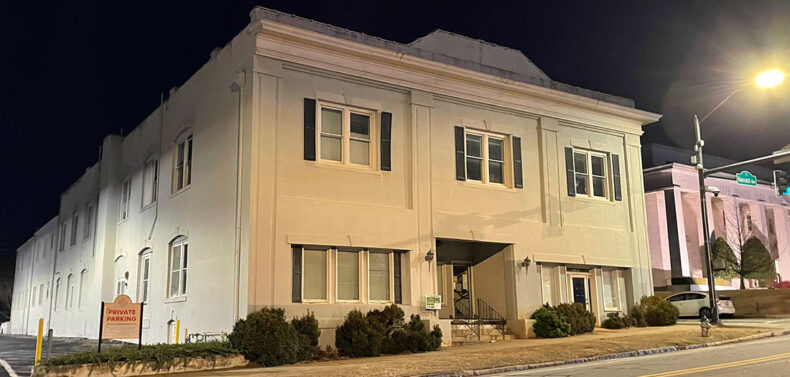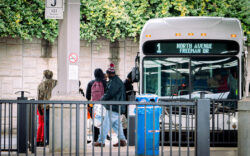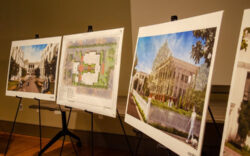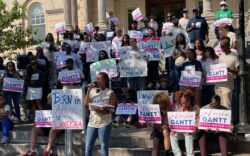A century-old building in downtown Athens, thought to be saved when Athens-Clarke County created a new historic district five years ago, is now once again threatened as the county commission considers a settlement allowing the church that owns it to tear it down.
Preservationists have been working to save the Saye Building at the corner of Lumpkin Street and Hancock Avenue for the past month, since the ACC Commission preliminarily gave its blessing for First United Methodist Church to demolish it and build a parking lot on the property, including offering to buy the building.
“Athens deserves better than to lose a building with such potential for so little in return,” said Denise Sunta, engagement coordinator for Historic Athens.
When First Methodist initially applied for a demolition permit in 2018, Melissa Link used her power as a county commissioner to place a temporary hold on the teardown to buy time to consider alternatives. The full commission then included the Saye Building in a 2019 downtown demolition moratorium and the subsequent creation of the West Downtown Historic District in 2020, prompting years of appeals and litigation by the church. The district protects the Hot Corner, a historic center of African American culture and commerce, as well as landmarks of the Athens music scene.
In 2023, First Methodist tried again to obtain a demolition permit. It was denied by ACC planning staff, then on two appeals. The church sued, and Superior Court Judge Lisa Lott ordered the dispute to mediation in July. As a result of that mediation, the commission approved a resolution in November allowing the church to tear down the building.
Link was the only commissioner to vote in opposition. “We are giving special consideration to a religious organization by doing this,” she said. “I don’t believe we would come to the same conclusion if it were any random developer, and I will continue to vote no.”
But first, the teardown has to go through the process again. At a Jan. 21 meeting, the Historic Preservation Commission voted down a request to remove the Saye Building from the West Downtown Historic District.
Originally built sometime between 1918–1926, with an addition sometime in the 1960s, the office building is run-down and would be too expensive to renovate, according to Ben Griffith, chair of First United Methodist’s board of trustees. The church bought the building in 2004, but by around 2015 the maintenance costs had gotten too high, so the church formed a building committee that hired an engineer to assess its condition.
“Demolition wasn’t really in the cards at that point,” Griffith told the HPC. “But what they found, what we found, was that the building was in just horrible condition. All the systems would need to be replaced. It posed a safety risk to the community, and the costs would be just staggering to come in and repurpose that building.”
Griffith acknowledged that the church does not really need the parking, and said the long-term plan is to replace the Saye building with one better suited for classrooms and meeting space.
However, others insisted that the existing building can be saved. “While its current appearance may seem rugged, it’s entirely salvageable and no worse than other historic preservation projects that have transformed neglected spaces into community assets,” Sunta said, noting that tax credits are available to renovate historic buildings.
Historic preservation advocate Michael Ruppersburg pointed to similar projects like Ciné (formerly a tire recap plant), Creature Comforts (a former tire store), the Costa Building next to City Hall (a former ice cream shop), the old furniture store where Trappeze is now located, the old Lamar Lewis shoe store (now Tweed Recording) and the Southern Bell building, which is being converted into a boutique hotel. “The building can and should be saved,” he said, “and we can put it back to use like all these buildings we’ve talked about.”
Around the same time, a group of investors led by downtown business owner and former commissioner Russell Edwards, historic preservation consultant Chris Jackson and lawyer Gray Reilly made a formal offer to buy the Saye Building for $2 million. Historic Athens has urged the church to accept the offer, but Edwards told Flagpole he has not received an answer.
“If the owner cannot realize the immense potential of this property, it should sell it to someone who can,” Sunta said.
HPC members said they were concerned about setting a precedent by removing the property, but Thomas Mitchell, the attorney representing the ACC government, said the resolution specifically states that it should not be construed as precedent-setting.
If the property is removed from the historic district, a demolition permit could be issued. The second part of the process involves obtaining a special use permit to build a parking lot, which must go through the ACC Planning Commission.
“This can be a better use,” former mayor Gwen O’Looney told planning commissioners at a Feb. 6 meeting. “This does not fit any plans for our community.”
Sunta called it “a critical link between the east and west downtown districts, and its significance extends beyond its walls.”
Historic preservation advocate Amy Andrews told the planning commission that the church destroyed “a very successful African American office and professional building on the corner of Washington and Hull streets for the parking lot behind their building. So they don’t always act in the interest of the public. They’re acting in their interests, so we have to make our decisions on what’s best for our interests.”
Planning Commission Chairman Matthew Hall said parking “seems like a particularly terrible land use for a downtown zone.” The planning commission voted to table the special use request for 60 days. Members said they want the historic district issue to play out first, because it could influence their vote on the special use permit.
Ultimately the county commission will have the final say. “All this resolution does is start that process. There will be another vote that comes at the end,” Mitchell told the HPC. “From my perspective, my anticipation is that they will approve the necessary pieces to settle the case.”
Like what you just read? Support Flagpole by making a donation today. Every dollar you give helps fund our ongoing mission to provide Athens with quality, independent journalism.










